Once you try this focaccia bread recipe, you’ll never go back to plain bread! This hearty No-Knead Focaccia bread has tons of airy bubbles and is coated in olive oil and herbs, making every bite full of delicious flavor. And the best part? This easy no knead technique only takes about 5 minutes of hands-on work to make an amazing loaf. This delicious focaccia bread pretty much makes itself!
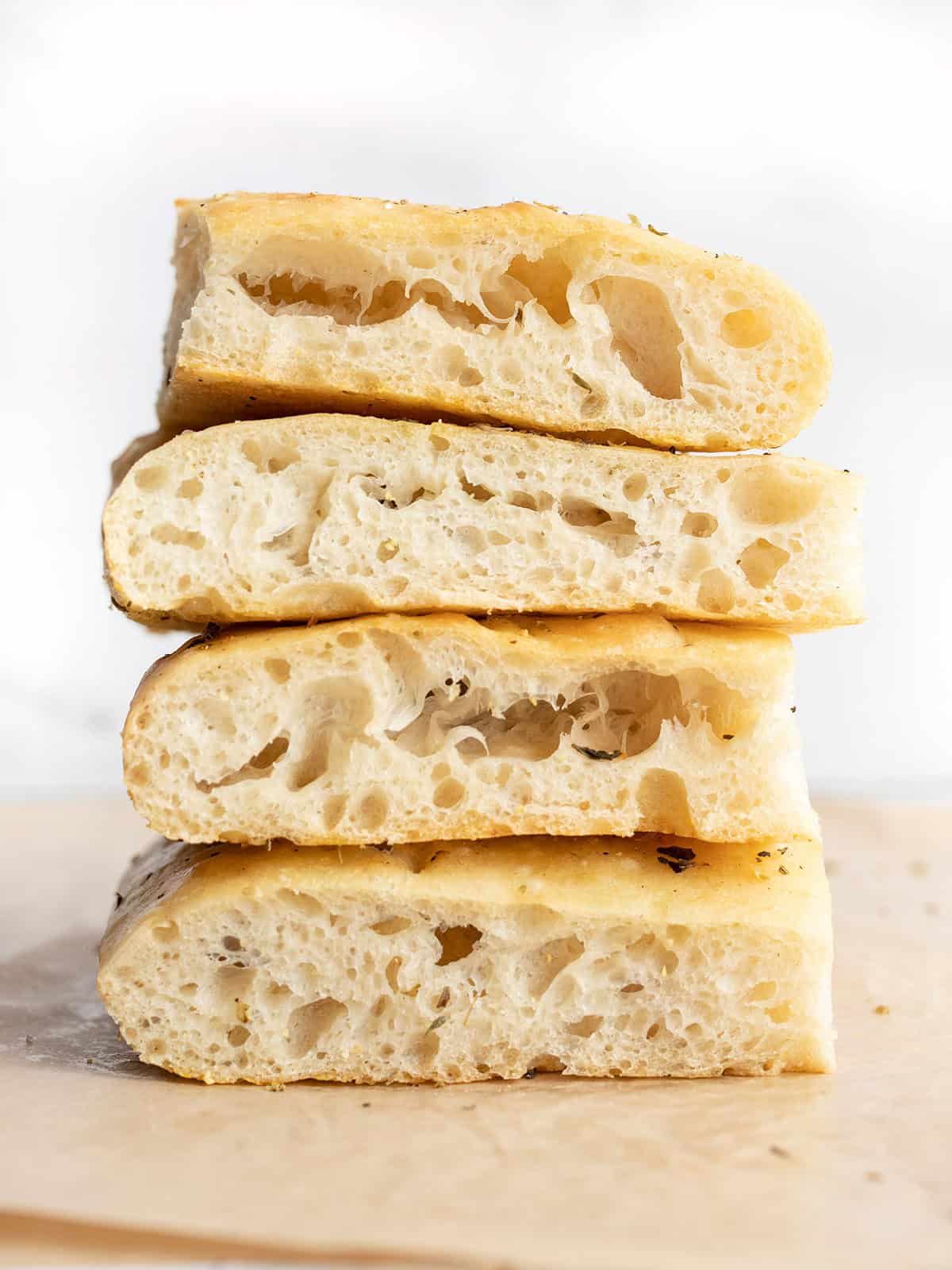
This post contains some affiliate links, which means that we make a small commission off items you purchase at no additional cost to you.
What is Focaccia?
Focaccia bread is an Italian flatbread known for its thick, fluffy texture with plenty of large bubbles. It is often rectangular or circular in shape and is made with high-gluten flour and plenty of olive oil, which gives it a unique texture and flavor. Focaccia can be seasoned with herbs, cheese, or even vegetables and is often used for sandwiches, dipping into soups or sauces, or even as thick base for pizza.
Ingredients for No Knead Focaccia Bread
This super simple no knead focaccia bread recipe only uses a few simple ingredients:
- Flour: Traditionally, focaccia is made with a high-gluten flour that gives it extra strength and a deliciously chewy texture. We crafted this recipe using all-purpose flour to reduce the need to purchase special ingredients. You can use high-gluten flour if you prefer, but the water-to-flour ratio may change slightly.
- Instant Yeast: Because this focaccia recipe uses a no-knead technique, we must use instant yeast which does not need to be bloomed in warm water to activate.
- Salt: Salt helps give the focaccia bread flavor. Without salt, bread can be quite bland and flavorless.
- Water: Water hydrates the flour and helps the yeast activate.
- Olive Oil: Olive oil keeps the focaccia dough from sticking, gives the bread’s crust a wonderful texture, and provides a classic flavor.
- Cornmeal: We use cornmeal to give the bottom crust of the focaccia bread a nice crispy texture, but it is optional.
- Italian Seasoning: A simple Italian seasoning blend is used to give the bread even more flavor, but you can experiment with your focaccia bread with other herbs, spices, cheese, or even vegetables.
Can I Use Whole Wheat Flour?
Yes, you can substitute some of the all-purpose flour for whole wheat flour. Using all whole-wheat flour generally creates a very heavy and dense bread, so I highly suggest using only some, up to 50%, whole wheat flour. You may need to use slightly more water, as whole wheat flour absorbs more moisture than all-purpose flour.
The No Knead Bread Technique
Regular bread baking requires the dough to be kneaded a long time to make the gluten strands line up and form a sort of matrix that gives the dough strength and texture. With no-knead bread, the dough is allowed to ferment overnight. During fermentation enzymes break down the gluten in a process called autolysis, which makes it easier for them to untangle, line up, and form the matrix that usually takes a lot of kneading to form.
An added bonus is that overnight fermentation adds a lot of flavor to the bread. AND, since the yeast has so much time to grow and multiply, you only need to use ¼ tsp yeast, compared to about 2 tsp for a normal loaf of bread! Win-win!
What Do You Serve With No Knead Focaccia?
Focaccia is such a versatile bread! It makes a great side dish with just about any meal, but I think it’s particularly nice with soups and stews. Its hearty texture makes it great for dipping, dunking, and sopping up sauces, stews, and soups. Focaccia bread is also fantastic for sandwiches, especially pressed sandwiches like paninis. You can also use this bread to make pizzas or flatbreads. Simply top it with your favorite cheese, meat, or vegetables and bake again until the cheese is melted and bubbly. Or, if you’re just a bread fanatic like me, slice it into sticks, dip it in some homemade marinara sauce, and call it a day!
How to Store Focaccia Bread
After baking, make sure to allow the focaccia bread to cool completely to room temperature before storing to prevent condensation. Once cooled, you can keep the bread at room temperature in an air-tight container for about two days. If you can’t consume the entire loaf within two days, consider freezing a portion of it for longer storage.
To freeze the focaccia bread, simply let it cool completely until it is room temperature, cut it into slices (whichever size or shape you prefer), then place it in a gallon-sized freezer bag. The frozen no-knead focaccia thaws quickly at room temperature.
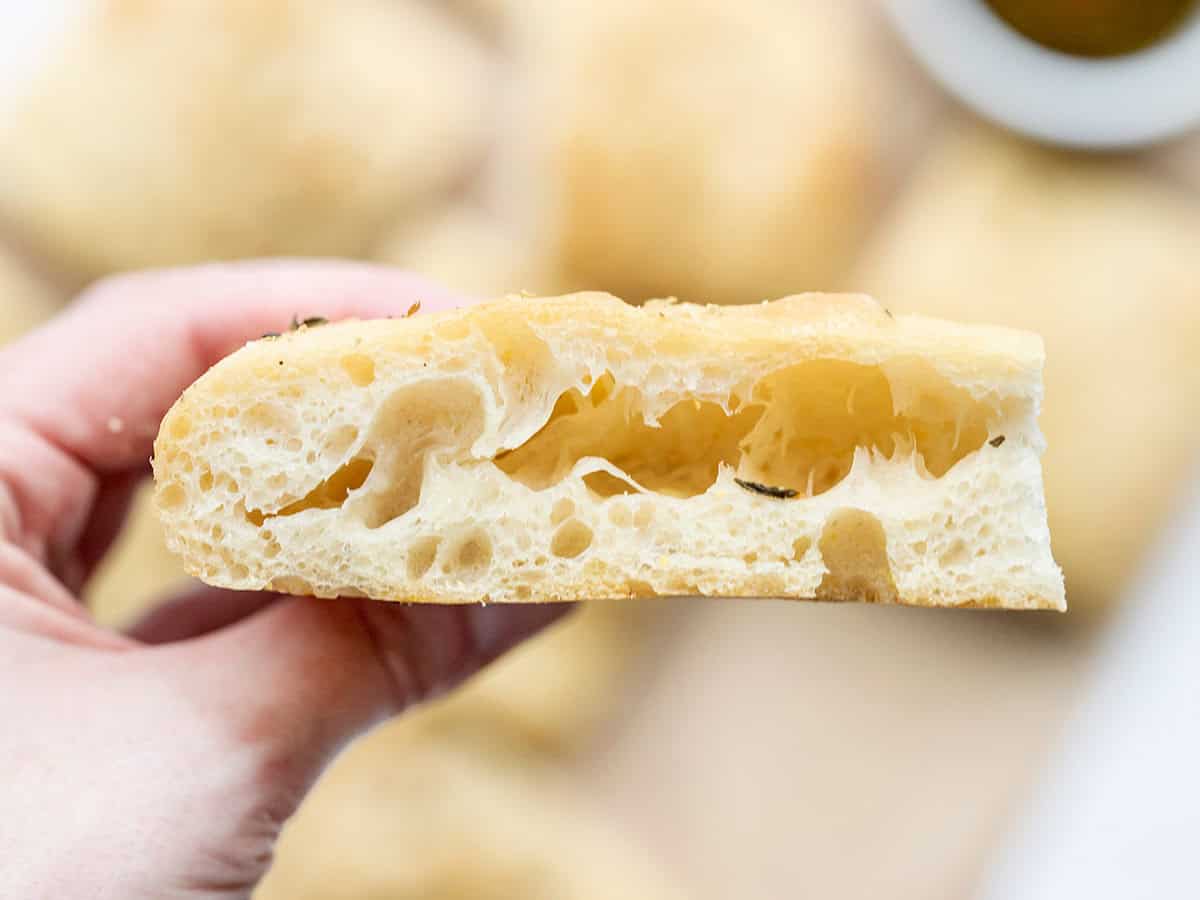
No Knead Focaccia Bread

Ingredients
- 4 cups all-purpose flour ($0.61)
- 1/4 tsp instant yeast ($0.02)
- 1 1/2 tsp salt ($0.03)
- 2 cups water ($0.00)
- 2 Tbsp olive oil, divided ($0.32)
- 2 Tbsp cornmeal ($0.03)
- 1 Tbsp Italian seasoning ($0.30)
Instructions
- The night before, combine the flour, salt and yeast in a bowl. Stir until everything is evenly combined. Add the water and stir until it forms one cohesive, sticky, shaggy ball of dough with no dry flour left on the bottom of the bowl. If there is still dry flour in bowl, add a little water (1-2 Tbsp) until the dough comes together (scroll down to the step by step photos for examples). Loosely cover the bowl and let sit at room temperature for 12-18 hours.
- The next day the dough will be wet, bubbly, and very fluffy. Dust the top of the dough with some flour, then scrape the dough from the sides of the bowl. Turn the dough over on itself a few times until it forms a ball in the center of the bowl.
- Line a baking sheet with foil then drizzle with 1 Tbsp olive oil. Spread the oil to coat the surface of the foil, then sprinkle cornmeal on top of the oil.
- Transfer the dough to the baking sheet. Stretch and pat the dough out into a large rectangle. You may need to dust your hands with flour throughout this process to keep the dough from sticking.
- Drizzle olive oil over the surface of the dough and use a soft brush to spread it evenly over the surface. Sprinkle the Italian seasoning (or any type of herbs) over top. Let the dough rise for another hour.
- Preheat the oven to 425ºF. Using your fingers, press dimples into the risen dough. Bake the focaccia for 20-25 minutes in the preheated oven or until the surface is golden brown. After removing from the oven, allow the focaccia to cool before slicing and serving.
See how we calculate recipe costs here.
Equipment
- Measuring Cups Spoons
- Liquid Measuring Cup
- Enamelware Sheet Pan
Nutrition

How to Make No Knead Focaccia Bread – Step By Step Photos

Start with 4 cups all-purpose flour, ¼ tsp instant yeast, and 1.5 tsp salt. Stir them together until everything is well combined.

Add 2 cups water to the flour mixture. This part will require a little flexibility on your part. You may need to add slightly less or slightly more water depending on the ambient humidity in your home and fluctuations with measuring the flour. I’ll show you what to look for in the next photos.

Stir the water into the flour until it forms a ball of sticky dough and there is no more dry flour left on the bottom of the bowl. In the photo above, the dough is too dry. You can see dry flour on the bottom of the bowl and the dough ball is not cohesive. If this is your dough, add a tablespoon or two more water.

Your dough should look like this. Sticky, but not slimy or shiny, and no dry flour on the bottom of the bowl. This style of dough is much more wet than traditional bread dough. Cover the bowl loosely and allow it to sit at room temperature for 12-18 hours.

After 12-18 hours the dough will look very bubbly and large, like this. Am I weird for thinking that’s gorgeous??

Sprinkle a little flour over the dough to keep your hands from sticking and pull the dough from the sides of the bowl. Turn the dough over onto itself a few times until it forms a sort of ball. Keep your hands well floured as you do this.

This is what the dough looks like after I folded it onto itself a few times. The gluten matrix is well developed. You can tell by how smooth it is and the air bubbles trapped right under the surface.

Line a baking sheet with foil, then drizzle 1 Tbsp olive oil over the surface. Use your hands to spread the oil to evenly coat the surface of the foil, then sprinkle about 2 Tbsp cornmeal over the oil.

Transfer the ball of dough to the prepared baking sheet and press and stretch it out until it fills the entire baking sheet. Drizzle one more tablespoon of olive oil over the surface of the dough, then sprinkle 1 Tbsp Italian seasoning over the surface (you can use a mix of basil, oregano, and red pepper if you don’t have Italian seasoning).

Let the dough rise for one hour (or a little more if your ambient room temperature is on the cool side). When you get close to the end of the rise time, begin preheating your oven to 425ºF. Use your fingers to make dimples all over the dough.

Once the focaccia has risen and the oven is fully preheated, transfer the baking sheet to the oven and bake the focaccia bread for 20-25 minutes, or until it is nicely golden brown on top.

Look at those gorgeous bubbles!

Let the focaccia bread cool before slicing. You can slice it into 12 squares, or into strips, which are nice for dipping and dunking into soups and stews.


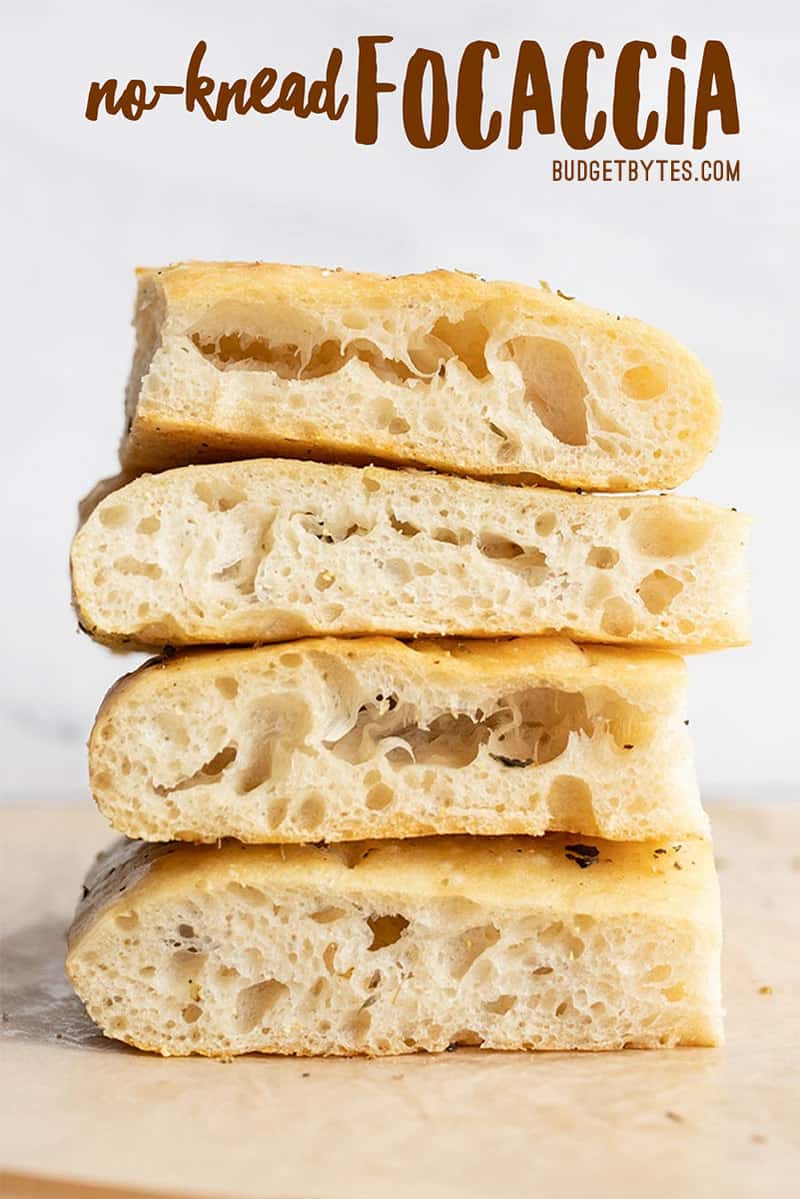
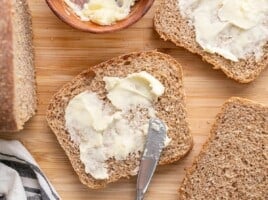
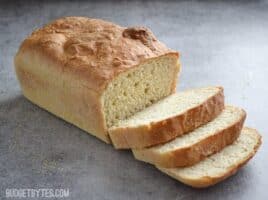
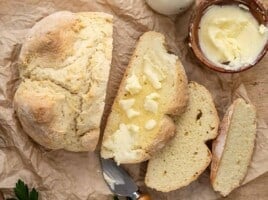
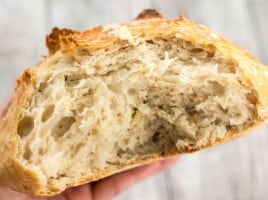
I love all your no-knead breads and am making this one now! What size baking pan is recommended?
26″x18″ is a standard size that will work.
Love this recipe and have used it so many times! I actually recently made it and I did not have wheat flour so I subbed for semolina flour and it worked really well!
I can’t seem to get this right… As a no-knead first timer, do you have any tips or techniques on stirring in the water? I’ve tried twice, both batches became too clumpy to stir and a cohesive dough like in the picture never formed. The first dough I added extra water which quickly became much too wet. The second try I ended up overworking because I was afraid of adding to much water so I kept stirring instead hoping all the flour would absorb. I added a bit of extra water but the end result dough was so tough and still clumpy.
Hmm, I think it’s just going to take that type of trial and error, unfortunately. But your instincts are right. If it’s clumpy and not coming together into one ball, it needs more water. Try just adding a tablespoon or two. If you accidentally go too far and it looks so wet that it’s glossy, you can dust it with a little extra flour. But it’s definitely better to have it be a little too wet than to be too dry. And as it ferments overnight it will become a little less clumpy, so don’t worry about the dough being super smooth or even. :)
Most amazing focaccia bread recipe ever – I’ve made over and over and it has become a reliable staple in our home. A keeper – easy, delicious, consistent…what’s not to love!
Thanks Barbara!
There used to be a Panzanella Salad that used this bread, but I’m not seeing it on the site. Any way to re-upload it or send it my way? Mostly looking for the dressing that was included in it! Thank you!
I just emailed a pdf of the recipe to you using the email you registered your comment with. :) Let me know if you need anything else!
This was so awesome!!!!
We didn’t have whole wheat flour so we used only regular flour.
We didn’t have corn meal so we just used the regular flour to keep the dough from sticking to the pan.
We skipped the step to let it rise 1 hour after putting the dough in the pan. (accidentally did this- dinner had to be cooked and we couldn’t wait another hour).
All turned out fantastic!!! Tomorrow, we are planning on what sandwiches we are having!
The room temp here is an airconditioned place? My country is very hot.. India .. do it would turn really sour on the counter…
Yes, “room temperature” in the United States is generally 72 degrees Fahrenheit. You can either let it rise for less time, or enjoy the extra flavor produced with the longer rise time.
When my kitchen is too cold, I put my dough in the oven, turned OFF but with the light on. It’s slightly warmer than “room temperature” by a few degrees, but I think it’s perfect.
This turned out delicious! It didn’t rise as much as I expected (on either the first or 2nd rise). I halved the recipe and it was perfect for dinner for 2. I also added fresh rosemary and other seasonings into the dough before the 2nd rise. Thank you for your bread recipes – they are fabulous!
Made this for dinner today! I added some garlic powder and Italian herbs to the dough, and also topped the bread with a bit of parmesan and mozzarella after about 20 minutes, then served it with marinara sauce. Super delicious and easy!
I made this day before yesterday and it was A.MAZ.ING!!! My first attempt at yeast bread. Thank you very much Beth. I am SO IN LOVE with you and your recipes. Really helps to have all the step by step pics with the recipe. Thank You Thank You
Thank YOU. :)
How far in advance is “overnight” if I want to make the actual bread the next evening (5pm), would you still recommend making the dough the night before (even as late as 10pm, which would be 20hrs)
Yep, I’d do 9 or 10 pm, or just before you go to bed. :) I’ve prepped it at 9pm before and then baked it around 5pm.
Foccacia success at last! I used bread flour in place of all purpose and had a nicely risen dough that puffed beautifully in the oven. The leftovers made excellent croutons.
I just stirred up this dough to ferment overnight for tomorrow’s dinner.
I’m fusing three of your recipes: mushroom, artichoke, spinach pasta, this one, and a recipe where you use this dough for pizza. I put chopped rosemary in the dough.
I’m making pizza with fresh mushrooms, canned artichoke hearts from Trader Joe’s <3, some spinach, and probably pepperoni for my adamant carnivore husband.
Thanks so much for your efforts to help us all eat better for less money!
Unfortunately, I didn’t enjoy this recipe for pizza dough as much as my usual for beer pizza dough from King Arthur Flour website. It may have benefited from a prebake before adding any toppings.
My husband liked it, and is taking it for work lunch today. He doesn’t appreciate crispy, “hard” pizza crust.
Maybe I’ll like it better after a reheat in the conventional oven.
I kept enough to use the dough as intended in a 9″ cake pan for focaccia, so I’ve got that frozen. I’ll bet it’s better.
Sounds amazing!!
Could active dry yeast be substituted for instant? if so- would it change rise times and ratios? Thank you!
Not for this recipe, unfortunately. Active dry must be proofed in hot water before adding to the recipe, whereas instant yeast can be added to the flour dry, without any activation by hot water. In general, you can use instant yeast in place of active dry in any recipe, but you can not use active dry in place of instant in recipes where it is not proofed first in hot water. I hope that made sense! :)
So…. Would it not be possible to first proof the active dry in the two cups of water warmed up, and then mix with the other dry ingredients? It seems this would solve the problem.
That can work, but sometimes depending on the moisture content of your flour, you may need to add a little more or less water. I’ve often thought of trying that method because it seems like it would work, but I haven’t tested it out yet.
I make this all the time with active dry yeast and it works great.
I sure do love your bread recipes! I just got back from Amsterdam and they have the BEST bread and sandwiches so I was hoping to recreate it at home. I’ve made the roll version of your focaccia before (and also commented on it…haha) adding olives, and I did the same here. I sprinkled rosemary on top. Unfortunately, I forgot to dimple the bread before sticking it in the oven, but it’s still delicious. The bottom did end up slightly soggy, which I realize now is because I left it to cool on the pan for too long, but I imagine it will dry out a bit now. All in all, the sandwich I made was beyond delicious, so I’d say it was a success!